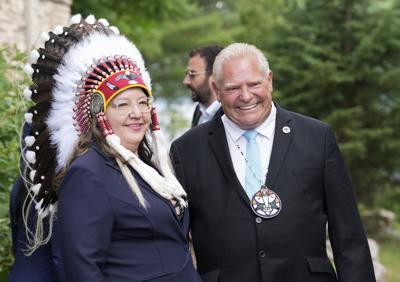HUNTSVILLE, Ont. — First Nations and first ministers tend to follow a familiar playbook at high stakes summits.
Call it the Canadian tradition of blending confrontation with consultation and stagnation. Time for an update.
Meeting in Muskoka on Monday, Indigenous chiefs and premiers sat down without the usual standoff. Possibly it was the bucolic setting at a scenic lakeside resort, but Ontario’s Doug Ford could be seen chatting and chuckling amiably with Assembly of First Nations National Chief Cindy Woodhouse Nepinak when they emerged.
The week before in Ottawa, by contrast, when Prime Minister Mark Carney met Indigenous leaders to defend his development plans, the reaction was far more tense. Why the change in atmosphere?
Perhaps it is in the nature of the political beast — on both sides — to raise the temperature and then cool things down. Elected first ministers and elected chiefs are politicians, after all, beholden to their constituencies but mindful of the changing political climate.
Compromise doesn’t come easy. But confrontation may not go down easy anymore, either.
The tension has been with us since time immemorial, not least since settlers started colonizing Canada long ago. But times are changing for Canada’s traditional political ritual.
Today, while First Nations leaders complain of past Canadian colonization, the public is focused on the American colonizer at the door. Is the colonizer about to be colonized?
The ground is shifting — not just on traditional Indigenous lands but across the land and beyond the border.
For all the historic allegations of exploitation, an existential crisis is facing the entire country in real time — if not quite conquest, then economic colonization. If Canada’s manufacturing base is sidelined and the government’s fiscal capacity undermined, that will surely undercut Ottawa’s future ability to funnel billions of dollars to First Nations reserves.
Against that backdrop, Ottawa, the provinces and territories have come together to kick-start economic development while streamlining the approval process. Given our unique demography, geography and geology, it is hardly surprising that our political leaders are pulling every lever, cutting every corner and clenching every cliché to get goods to market quickly and competitively.
But after pushing the envelope, first ministers of every political stripe have faced pushback for moving too far, too fast. Not just Carney’s Liberal government in Ottawa and Ford’s Progressive Conservative government at Queen’s Park, but also NDP governments in B.C. and Manitoba have been rebuked.
Yet none has faced as much fury as Ford. Ontario’s premier is front and centre because he has legislated the most aggressive process, pushing “special economic zones” that give him added powers, notably in the Ring of Fire on Indigenous territory in the far north.
It’s not just Ford’s future ambitions but his past track record that have raised hackles. His transgressions on the Greenbelt’s protected lands ringing ��ѻ��ý suggest he might also trample on protected treaty lands ringing the province.
After rushing through legislation without consultation last month, the premier was in a hurry to calm the waters at the heavily guarded Deerhurst Resort in Huntsville. Perhaps mindful of threatened protests for the long hot summer of 2025 — which have not materialized in Muskoka — Ford tried to talk his way out of trouble.
“It’s all about building relationships,” he mused after the meeting, but then quickly asserted that most of the Indigenous chiefs he talks to are tired of talking: “The number one thing I heard is start moving — stop talking and start moving.”
Yet the premier stressed he won’t trigger any fast-moving projects “without a green light from First Nations communities.”
For their part, Indigenous leaders insist they are not anti-development, merely anti-diktat. They want consultation and collaboration, not unilateral legislation that ignores the government’s duty to consult — and they want it at their own pace.
“Our First Nations are not here to block roads but to build bridges,” said Linda Debassige, grand council chief of the Anishinabek Nation.
The AFN’s Woodhouse Nepinak said different First Nations have diverse views, but there is common ground about America’s overreach.
“For sure I think that we are all united against Trump’s illegal tariffs,” she told reporters. “We want prosperity, but not at the expense of our rights.”
Canada’s first ministers counter that there will be consultation in due course, even if their lightning-quick legislation pre-empted the discussion. Clearly, provincial and federal governments feel a new urgency, driven by renewed anxiety among voters.
But in their hurry, they skipped a step. Now, amid the pushback, they have to backtrack.
Which means that the latest divide between First Nations and first ministers is as much about process as substance. Indigenous leaders say they need more time to get it right, respecting both their rights and rhythms, but time is short.
When all is said and done, both sides still need to talk it out, striking a balance between consultations and decisions. The last thing that First Nations and the entire country need is more confrontation and litigation amid the spectre of economic colonization.
Error! Sorry, there was an error processing your request.
There was a problem with the recaptcha. Please try again.
You may unsubscribe at any time. By signing up, you agree to our and . This site is protected by reCAPTCHA and the Google and apply.
Want more of the latest from us? Sign up for more at our newsletter page.



























To join the conversation set a first and last name in your user profile.
Sign in or register for free to join the Conversation